Medical Disclaimer: This article is for informational purposes only and does not replace professional veterinary advice. Always consult your veterinarian before beginning new treatments.
Table of Contents
Watching your dog struggle with vomiting, diarrhea, or a poor appetite can be heartbreaking. As a veterinarian, I’ve seen how unsettling dog digestive issues are for families especially when standard treatments take time to work. The good news? You can offer gentle, hands-on relief at home. With the right techniques, dog acupressure points can ease discomfort, stimulate digestion, and bring peace to both of you.
Acupressure is a form of holistic healing for dogs, rooted in Traditional Chinese Medicine. It uses finger pressure on specific points to help energy flow smoothly. In my Ottawa clinic, I’ve often recommended it as a complementary therapy for pets with chronic gastrointestinal problems especially when stress is part of the picture. In this guide, you’ll learn how to identify and use the top 5 dog acupressure points to naturally support your dog’s digestive health.
Key Takeaways
- Dog acupressure points can safely support digestion by improving energy flow, reducing nausea, and relieving constipation or diarrhea.
- Acupressure is part of holistic healing for dogs a gentle, hands-on approach that promotes wellness without medication.
- The top five points for dog digestive issues are ST 36, SP 6, PC 6, CV 12, and LI 4. Each targets specific symptoms like vomiting, poor appetite, or gas.
- Sessions take just 5–10 minutes and can be done at home with minimal tools.
- Acupressure is most effective when paired with a vet-guided treatment plan and healthy diet.
Always check with your vet before starting, especially if your dog is pregnant, senior, or has chronic illness.
What Causes Digestive Issues in Dogs?
You can visit: https://doglifeexpert.com/can-dogs-eat-oranges-top-10-surprising-truths/
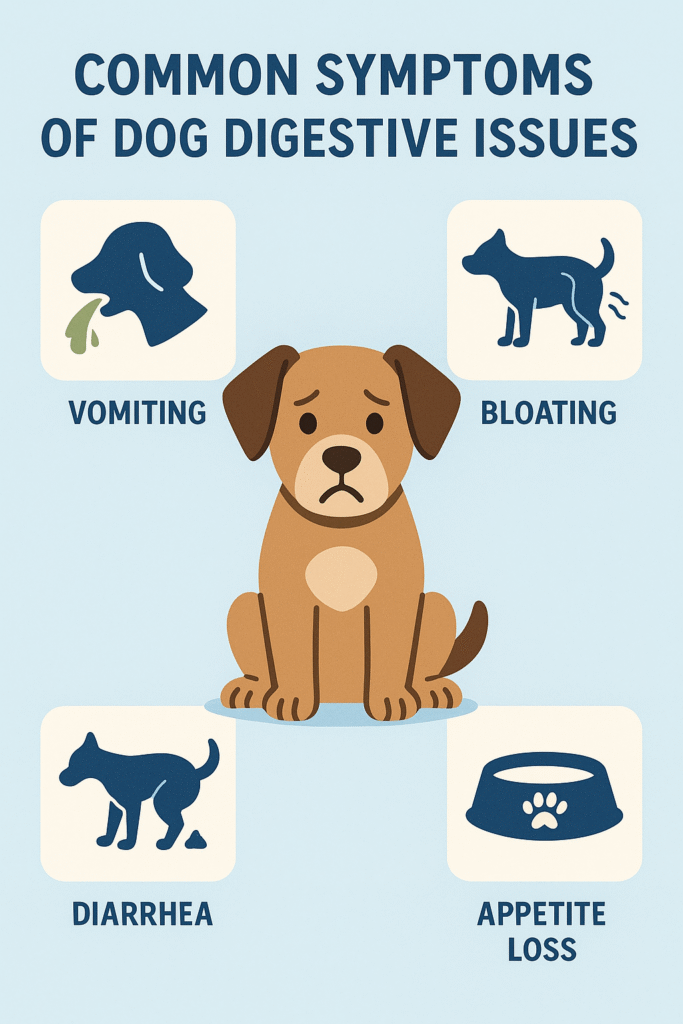
Digestive issues in dogs can range from mild tummy upsets to chronic health conditions that affect quality of life. As a vet, I often see cases where early signs like gas, occasional vomiting, or loose stool are ignored until symptoms worsen. Understanding the root cause is the first step before using any dog acupressure points.
Common Digestive Symptoms in Dogs
Recognizing the early signs of dog digestive issues is key to catching problems before they become serious. Here’s what to watch for:
Vomiting or Regurgitation
Vomiting involves active retching and the forceful expulsion of stomach contents, while regurgitation happens passively often right after eating without abdominal effort. Occasional vomiting may result from minor upsets, but frequent or projectile vomiting could indicate gastritis, pancreatitis, dietary indiscretion, or even foreign body obstruction.
Diarrhea or Soft Stools
Loose or watery stools are common signs of gastrointestinal imbalance. They can stem from food changes, intestinal parasites, infections, stress, or chronic conditions like inflammatory bowel disease. Diarrhea that persists for more than 48 hours or contains blood requires prompt veterinary attention.
Constipation or Straining
Constipation involves infrequent, difficult, or painful defecation. Dogs may squat repeatedly with little result or produce hard, dry stool. Causes include dehydration, lack of dietary fiber, orthopedic pain, or even blockages. Chronic constipation can strain the colon and should not be ignored.
Excessive Gas or Bloating
While some flatulence is normal, excessive gas may point to dietary intolerance, gut dysbiosis, or slow digestion. If your dog shows signs of abdominal distension, restlessness, or tries to vomit without success, it could indicate life-threatening bloat seek emergency care immediately.
Reduced Appetite or Weight Loss
Skipping meals, sniffing but not eating, or sudden disinterest in food can signal nausea, dental pain, metabolic disease, or anxiety. Unexplained weight loss over time often indicates malabsorption, chronic inflammation, or liver disease issues that acupressure alone cannot resolve.
Being familiar with these symptoms helps you determine when dog acupressure points might help and when a vet visit is more appropriate. Acupressure can support digestion and comfort, but a professional diagnosis is always step one in holistic healing for dogs.
Potential Causes
- Dietary indiscretion: sudden changes in food, garbage ingestion
- Food allergies or intolerances: especially to common proteins or grains
- Stress or anxiety: leading to upset stomach or nausea
- Parasitic infections: like giardia or roundworms
- Chronic conditions: such as inflammatory bowel disease, pancreatitis, or liver dysfunction
If your dog has persistent or severe symptoms, diagnostic tools like bloodwork, stool analysis, or imaging may be needed. While acupressure can’t cure these underlying problems, it supports holistic healing for dogs by easing symptoms like nausea and discomfort.
For example, I once treated a senior dog with IBD who flared up every time there was loud construction near the house. By combining medical therapy with targeted dog acupressure points, we helped calm her gut and reduce episodes without needing to increase medications.
How Acupressure Supports Digestive Health
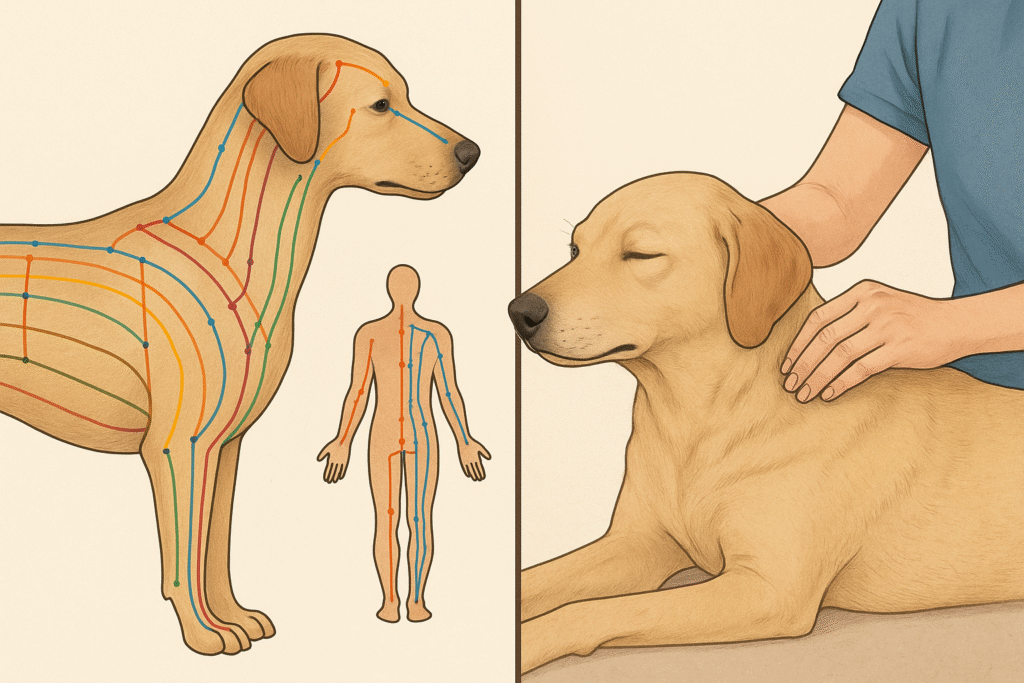
Acupressure is a key part of holistic healing for dogs, especially those dealing with chronic or stress-related digestive issues. It works by stimulating specific points on the body called dog acupressure points that help regulate internal organs, boost circulation, and calm the nervous system.
Traditional and Modern Perspectives
In Traditional Chinese Medicine (TCM), digestive imbalances are often linked to disruptions in the spleen, stomach, and liver meridians. When energy (Qi) stagnates in these pathways, dogs may experience vomiting, bloating, or diarrhea. By pressing on strategic points, acupressure helps unblock these channels and restore harmony.
Western research supports this approach. Though more studies exist for acupuncture, a 2015 study in Veterinary Medicine International found acupuncture significantly improved stool quality and gut motility in dogs with chronic diarrhea benefits likely shared with acupressure.
Real-World Results from Practice
In my Ottawa practice, I’ve used acupressure to support dogs who:
- Lose their appetite during boarding or car rides
- Struggle with post-surgical constipation
- Experience anxiety-triggered vomiting
- Flare up with IBD during weather changes
Using dog acupressure points for these cases often shortened recovery time and improved comfort without side effects. Best of all, it allows pet parents to take an active role in care, deepening the bond between them and their dogs.
5 Dog Acupressure Points for Digestive Relief
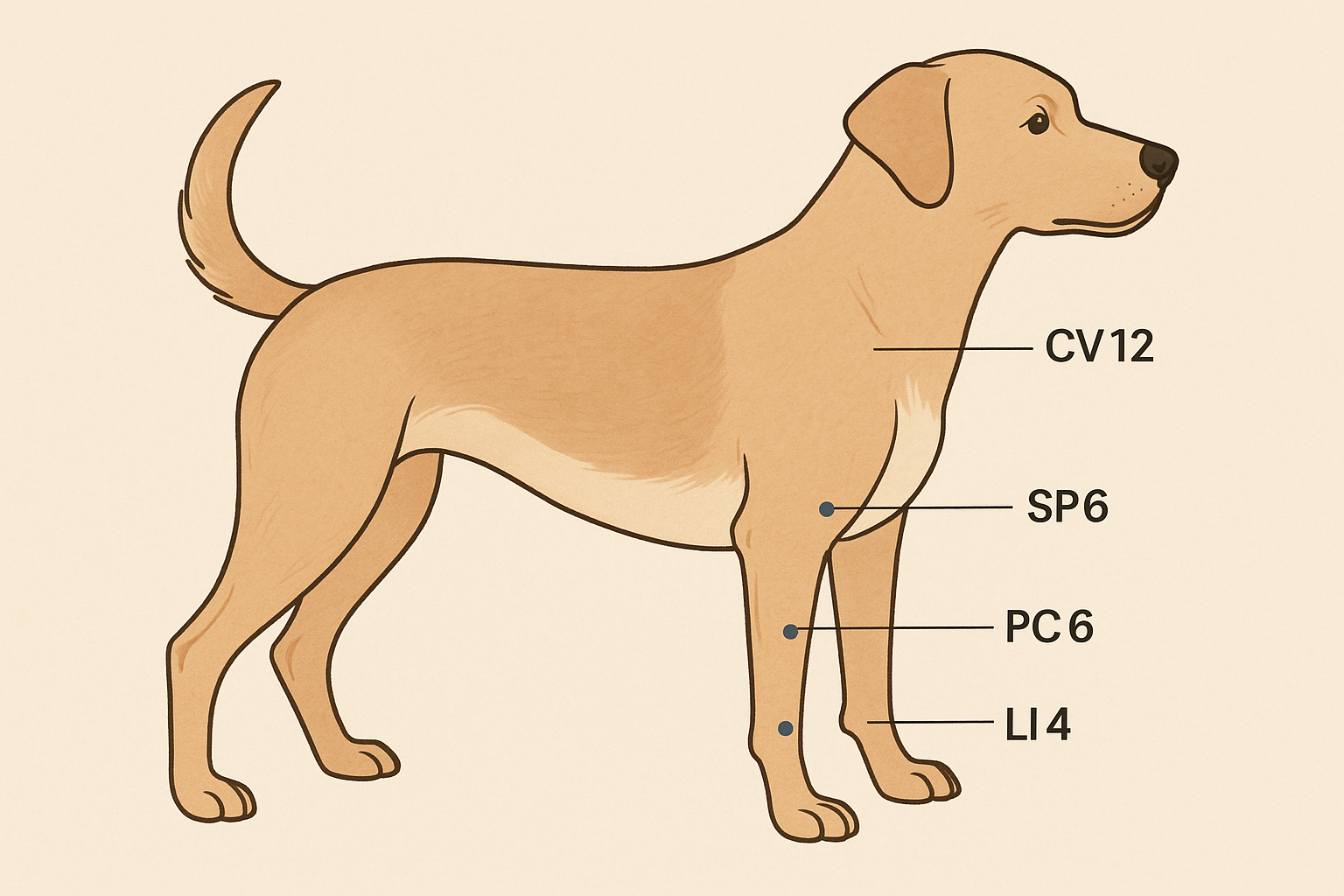
Each of these dog acupressure points targets a different aspect of digestion from stimulating appetite to reducing bloating. Learning where and how to apply pressure gently can provide real comfort during flare-ups of dog digestive issues.
https://www.vet.cornell.edu/…/gastric-dilatation-volvulus-gdv-or-bloat
| Point Name | Location | Benefits | Cautions |
|---|---|---|---|
| ST 36 (Stomach 36) | Outside of hind leg, just below the knee | Strengthens digestion, reduces vomiting/diarrhea | None, generally safe |
| SP 6 (Spleen 6) | Inside of hind leg, 1/4 way up from ankle, behind tibia | Reduces bloating, regulates stools | Avoid in pregnant dogs |
| PC 6 (Pericardium 6) | Inside front leg, just above wrist, between tendons | Soothes nausea, calms anxiety | None |
| CV 12 (Conception Vessel 12) | Midline of abdomen, between navel and ribcage | Supports stomach function, reduces gas | Light pressure only |
| LI 4 (Large Intestine 4) | Webbing between dewclaw and next toe | Boosts motility, helps constipation | Avoid in pregnancy |
Application Tips:
- Use your thumb or finger to apply light, circular pressure for 30–60 seconds.
- Observe your dog’s reaction signs of relaxation like licking, sighing, or lying down are great.
- Combine 2–3 points per session for the best effects.
- Practice daily, especially during flare-ups of dog digestive issues.
These five dog acupressure points are my go-to recommendations in clinic for pets with sensitive guts. With time and consistency, they can become a soothing part of your dog’s routine and support long-term holistic healing for dogs.
How to Perform Acupressure on Your Dog
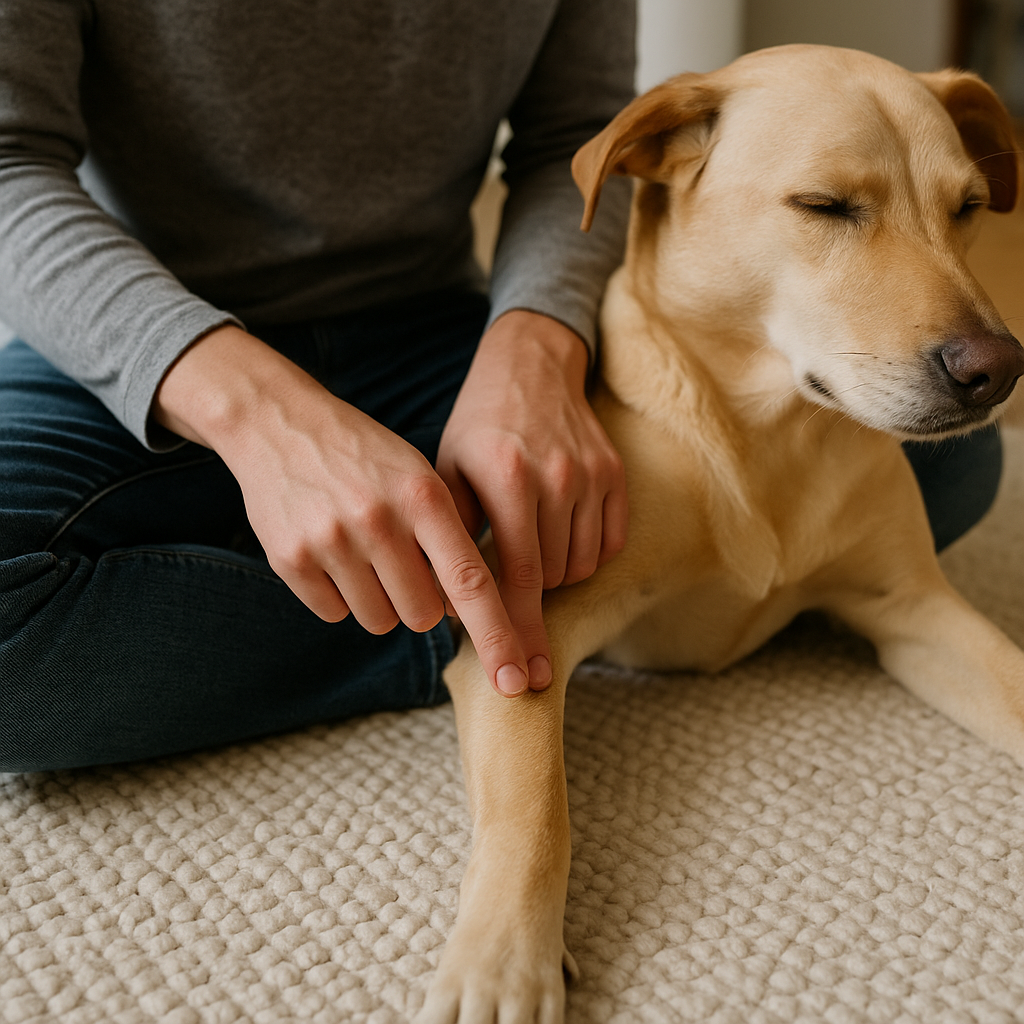
Practicing acupressure at home is simple and safe with a little preparation. Many clients tell me their dogs start looking forward to these sessions once they associate them with calmness and relief from dog digestive issues.
Step-by-Step Instructions
- Create a Calm Space
Choose a quiet area with minimal distractions. Use a mat or their bed for comfort. - Relax Your Dog
Spend a few minutes petting or massaging your dog to help them settle. - Locate the Right Points
Refer to a chart or veterinary resource to find the proper dog acupressure points. Feel for soft indentations or grooves. - Apply Gentle Pressure
Use your fingertip or thumb to press in small circles for 30–60 seconds. Start light never force it. - Watch for Feedback
Positive signs: sighing, stretching, licking lips.
Negative signs: pulling away, growling if so, stop and try later. - Keep It Brief
Limit sessions to 5–10 minutes, 1–2 times daily. Focus on 2–3 points per session.
5-Minute Home Checklist (Box)
✔ Quiet, familiar setting
✔ Clean hands and trimmed nails
✔ Use light, circular motion
✔ Reward with treats or praise afterward
✔ Track changes in symptoms (vomiting, stool, appetite)
Practicing these dog acupressure points regularly can reduce the frequency and severity of dog digestive issues. It’s a simple but powerful tool for holistic healing for dogs, especially when guided by your vet’s recommendations.
Typical Cost of Digestive Support in Canada
Managing dog digestive issues can be expensive, especially when chronic. Fortunately, using dog acupressure points at home offers an affordable way to complement care. Here’s a breakdown of typical Canadian costs (in CAD):
| Service or Product | Typical Cost | Notes |
|---|---|---|
| Veterinary exam | $80–$120 | Required for diagnosis |
| Bloodwork (basic) | $100–$200 | Often needed for chronic GI cases |
| Fecal exam | $40–$60 | Checks for parasites |
| Ultrasound | $300–$500 | Used for chronic or unclear cases |
| Prescription GI diet | $80–$120/month | E.g., Hill’s i/d, Royal Canin GI |
| Probiotics/supplements | $30–$60/month | Options: FortiFlora, Purina Calming Care |
| Acupressure session (pro) | $75–$125/session | With certified veterinary acupressurist |
| DIY acupressure | FREE | Once trained, no cost except time |
Learning dog acupressure points at home is one of the lowest-cost options in the realm of holistic healing for dogs. And it offers long-term benefits that go far beyond symptom relief like increased bonding, emotional regulation, and fewer vet visits.
Tips to Boost Results Naturally

While applying dog acupressure points can help manage symptoms, pairing it with smart lifestyle changes can amplify results. Many dog digestive issues have root causes in diet, stress, or gut health so a well-rounded approach works best.
Diet and Routine
- Stick to a consistent feeding schedule. Dogs thrive on routine.
- Avoid fatty foods, table scraps, or sudden food changes. These are top triggers for GI upset.
- Use a vet-recommended GI diet if your dog has chronic issues.
- Add probiotics like Purina FortiFlora to promote gut flora balance.
- Ensure proper hydration, especially during vomiting or diarrhea episodes.
Combine with Other Therapies
Know When Acupressure Isn’t Enough
While dog acupressure points offer gentle and effective support for many dog digestive issues, there are times when medical intervention is not just recommended it’s essential. Acupressure is a complementary therapy, not a replacement for veterinary care when serious symptoms arise.
If your dog shows any of the following signs, stop acupressure and seek immediate veterinary attention:
Ongoing Vomiting or Bloody Diarrhea
Persistent vomiting or stools containing fresh blood or dark, tarry material (indicating digested blood) could signal serious conditions like:
- Gastric ulcers
- Hemorrhagic gastroenteritis
- Intestinal parasites
- Ingestion of toxins or foreign objects
In these cases, dog acupressure points will not resolve the underlying issue and may even mask worsening symptoms. Delayed treatment can lead to dehydration, anemia, or life-threatening complications.
Severe Bloating or Abdominal Pain
If your dog’s abdomen is visibly distended, hard to the touch, or if they whimper, pace, or bite when touched, this could be:
- Gastric dilatation-volvulus (GDV or “bloat”) – a true emergency
- Pancreatitis
- Intestinal obstruction
These conditions often require emergency surgery, pain control, and hospitalization. Acupressure in such a state is inappropriate and can risk further injury.
Sudden Collapse or Lethargy
If your dog collapses, cannot stand, or becomes extremely weak or non-responsive, this may indicate:
- Shock
- Internal bleeding
- Sepsis from intestinal damage
- Severe dehydration or metabolic imbalance
Immediate diagnostics and fluid therapy are needed. These are not cases where acupressure can or should be attempted.
When in Doubt, Call Your Vet
Even in less obvious situations, such as intermittent vomiting or changes in appetite lasting more than 48 hours, it’s wise to contact your veterinarian first. Once a diagnosis is made and your dog is medically stable, you can ask whether specific dog acupressure points are safe and helpful to incorporate into recovery.
Always remember: acupressure is a tool in your toolkit not a cure-all. Knowing when to pivot to medical care is an essential part of responsible, holistic healing for dogs.
You must seek veterinary care immediately. Acupressure is a valuable part of holistic healing for dogs, but not a substitute for medical treatment in emergencies.
FAQs About Acupressure and Canine Digestion
1. Can I safely do acupressure on my dog at home?
Yes when done gently and with guidance, using dog acupressure points is very safe. Start slow, avoid painful areas, and always stop if your dog shows discomfort. Consult your vet first if your dog has major health concerns.
2. How often should I do acupressure for dog digestive issues?
For chronic or recurring symptoms, start with 5–10 minute sessions once or twice daily. Once your dog stabilizes, you can reduce to a few times per week for maintenance.
3. How long before I see results?
Some dogs improve within a few sessions especially those with stress-based symptoms like nausea or soft stool. For chronic dog digestive issues, it may take 1–2 weeks to see consistent changes.
4. Are there risks for senior dogs or puppies?
Generally no dog acupressure points are gentle and suitable for all ages. Just apply lighter pressure and avoid sensitive or surgical sites. Always skip LI 4 and SP 6 in pregnant dogs.
5. What if my dog won’t sit still during a session?
Try using treats, perform sessions during calm times (like before bed), or have a second person help. Keep it short and positive. With time, most dogs associate acupressure with relaxation.
This FAQ helps clarify key concerns for pet parents new to holistic healing for dogs, while reinforcing the safe and practical nature of home acupressure.
Real-World Cases from Practice
To illustrate the power of dog acupressure points in action, here are two real-world inspired cases that show how acupressure complements traditional care in managing dog digestive issues.
Case 1: Max, a Labrador with Chronic Diarrhea
Max, a 5-year-old Lab, had recurring bouts of diarrhea triggered by excitement or dietary slips. His vet prescribed a hydrolyzed protein diet and probiotics, which helped, but the episodes persisted. His owner added acupressure focusing on ST 36 and SP 6, twice daily. Within 10 days, Max’s stools improved in consistency, and his episodes became less frequent. His energy returned, and his owner was thrilled to have a natural tool for flare-up days.
Case 2: Bella, a Senior Beagle with Poor Appetite
Bella, aged 11, began skipping meals. Blood tests showed mild gastritis, and her vet recommended a bland diet and antacids. Her caregiver incorporated PC 6 and CV 12 daily, gently stimulating these points before meals. Bella responded well she began sniffing food again within days and was back to eating normally within a week. Her digestion stayed stable with regular acupressure and dietary care.
These examples show how dog acupressure points offer real-world value when added to a holistic healing for dogs approach especially for chronic, stress-sensitive cases.
Conclusion
If your dog struggles with vomiting, diarrhea, bloating, or appetite loss, there’s hope beyond medications alone. Learning a few key dog acupressure points gives you a gentle, natural tool to ease symptoms and support long-term gut health. As part of a broader plan that includes vet care, nutrition, and stress management, acupressure truly represents holistic healing for dogs.
You don’t need special equipment just your hands, a quiet space, and a bit of time. With practice, applying acupressure becomes a bonding moment that your dog will look forward to. Most importantly, it empowers you to take a more active role in your pet’s health journey.
Start slow, be consistent, and always work with your veterinarian especially if symptoms worsen or don’t improve. Whether your dog has chronic digestive issues or just the occasional upset, this guide puts safe, effective relief literally in your hands.

![You are currently viewing 5 proven Dogs Acupressure Points with Digestive Issues [Vet Guide]](https://doglifeexpert.com/wp-content/uploads/2025/07/ChatGPT-Image-Jul-14-2025-09_02_38-PM.png)
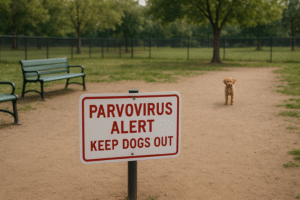

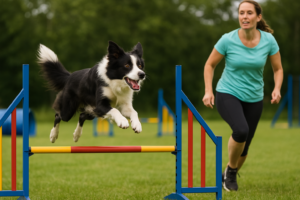
Pingback: “7 Powerful Fixes for Dog Dry Flaky Skin Backed by Science”